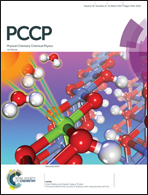In situ spectroscopic studies on vapor phase catalytic decomposition of dimethyl oxalate†
Abstract
Dimethyl Oxalate (DMO) has recently gained prominence as a valuable intermediate for the production of compounds of commercial importance. The stability of DMO is poor and hence this can result in the decomposition of DMO under reaction conditions. The mechanism of DMO decomposition is however not reported and more so on catalytic surfaces. Insights into the mechanism of decomposition would help in designing catalysts for its effective molecular transformation. It is well known that DMO is sensitive to moisture, which can also be a factor contributing to its decomposition. The present work reports the results of decomposition of DMO on various catalytic materials. The materials studied consist of acidic (γ-Al2O3), basic (MgO), weakly acidic (ZnAl2O4) and neutral surfaces such as α-Al2O3 and mesoporous precipitated SiO2. Infrared spectroscopy is used to identify the nature of adsorption of the molecule on the various surfaces. The spectroscopy study is done at a temperature of 200 °C, which is the onset of gas phase decomposition of DMO. The results indicate that the stability of DMO is lower than the corresponding acid, i.e. oxalic acid. It is also one of the products of decomposition. Spectroscopic data suggest that DMO decomposition is related to surface acidity and the extent of decomposition depends on the number of surface hydroxyl groups. Decomposition was also observed on α-Al2O3, which was attributed to the residual surface hydroxyl groups. DMO decomposition to oxalic acid was not observed on the basic surface (MgO).



 Please wait while we load your content...
Please wait while we load your content...